French Bulldog Colors
August 8, 2021 2021-08-08 19:41French Bulldogs are a common breed of dog in the United States. They originated around the 1800s in France as the result of mixing very small British Bulldogs. The French tended to prefer these smaller dogs over the larger ones, so they were the options that were often imported into France.
Over time, this led to the French Bulldog. The original Bulldog became too different from those developed in France, so they became their own breed.
These stocky, compact dogs are pretty popular companion animals. They come in many different colors. For instance, French Bulldogs come in brindle, fawn, white, and brindle and white. They are disallowed in a lot of different colors as well, though.
Still, some of these disqualifying colors are possible, even though they technically aren’t allowed.
In this article, we’ll take a look at their colors. Many of these dogs are extremely expensive. You can expect to find them for tens of thousands of dollars in some cases.
Table of Contents
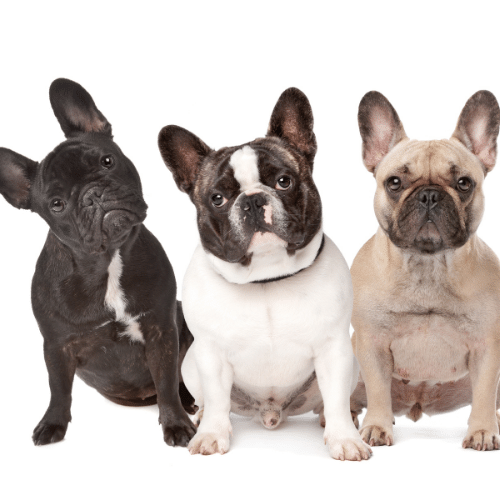
How Are French Bulldog Colors Produced?
Producing rarer colors is no joke. Many breeders spend years and even generations specializing their dog’s colors. A usual breeder may only produce a rare color every few years. Even a breeder that specializes in a rare color may only get a couple of dogs a year.
Some of these dogs are prone to health problems due to their rarer coloration. For this reason, finding a good breeder is significant. You don’t want to find a dog with the rarer color you’ve been looking for and then find that you have to spend thousands to keep them alive.
Many of these dogs are difficult to find. After all, they’re scarce. Plan on staying on a waiting list for a long time before you end up with one of these colors. Don’t plan on bringing home a blue French Bulldog next month. It may take a year or more before one becomes available.
Most breeders that sell rare colors are running family operations. Often, the current owner learned from their parents, who may have even learned from their parents. They have carefully cultivated these genes over a very long time, which is why they can produce puppies with such an unusual color.
Most of these breeders are experts on dogs. After all, you have to be after dedicating so much time to these canines. When you’ve been helping bred French Bulldogs since birth, you’re going to know quite a bit. We recommend asking these breeders all of your questions. Be sure to ask about genetic testing and the health of their dogs. Where the puppies are raised is often crucial for socialization purposes.
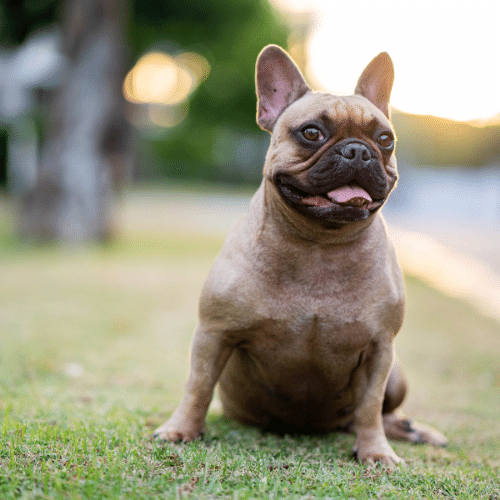
1. Sable
Sable French Bulldogs are not the rarest by any means. However, they can still be challenging to find and often cost more than other French Bulldogs out there.
They are technically another version of fawn, which is an official color recognized by the American Kennel Club. Instead of the usual fawn color, these dogs have a fawn coat with black tipping. They have a bit of a “washed out” look that sets them apart from the normal fawn coloration.
Many of these have a reddish pigment alongside their basic fawn coloration, which will make them look a bit tanner. The exact shade of their fawn color can vary widely. Some are pretty dark and have much more black tips; others are incredibly light.
Often, you’ll find these dogs at breeders that specialize in other fawn colorations. There are no known health problems associated with these colors.
2. Blue
Blue is one of the most well-known rare Frenchie colors. This is mainly due to social media, where many celebrities have shown off their blue dogs. While these dogs are called “blue,” they are more of a greyish-blue. Many people describe them as a slate color.
There is some controversy surrounding this dog breed. Some people claim that it is affected by different health problems, while others claim it isn’t. To understand why this color may cause different health conditions, it is essential to understand how it comes about.
To have a blue coat, the French Bulldog must inherit two copies of the dilute gene. This gene is recessive, so the dog has to have two copies. Otherwise, their other genes will cover up the color, and they will simply be a carrier.
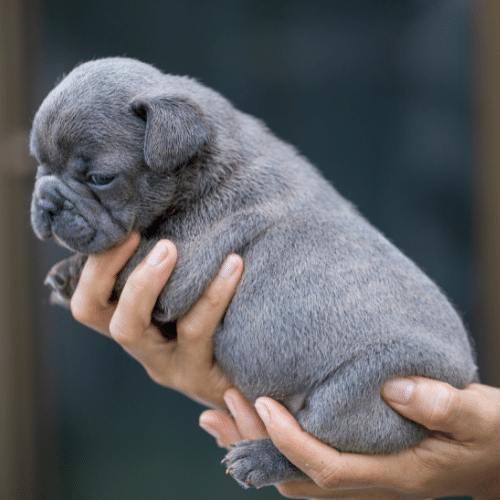
However, this gene affects more than just the color of the dog. It seems to play a role in the health of their coat as well. Many dogs with the blue gene are at a higher risk of color dilution alopecia. This condition causes patches of hair to thin and fall out. It sometimes includes flaky and itchy skin as well.
This condition isn’t severe. We also don’t know if it affects blue Frenchies mainly. Because this color is rarer in this breed, we don’t know if they are affected the same as other breeds. No studies have been done yet. However, many other breeds with blue coloration do have this disease, so there is a good chance it will affect the Frenchie.
These dogs usually cost anywhere from $4,000 to $6,000. This is quite expensive for a dog, especially a smaller one like the French Bulldog. However, you’re mostly paying for the rarity of the coat color.

3. Chocolate
The chocolate gene is recessive. For this reason, Chocolate French Bulldogs are pretty rare. For a dog to be chocolate, they must inherit a recessive chocolate gene from their parents. Otherwise, a dominant gene will cover the recessive gene up, preventing the dog from looking chocolate at all.
These dogs vary in shade. Some are darker brown; others are light brown. It depends on the dog’s other genes and how the chocolate gene is expressed. They tend to have lighter eyes like most diluted dogs. You can find them with eyes of green, brown, golden, and bright yellow. Those with “orange” eyes can be very expensive, as this eye color seems to be more sought after for one reason or another.
There are no known health conditions associated with this color. Unlike the blue gene, this one doesn’t seem to be connected to coat health adversely. However, that doesn’t mean these dogs are completely healthy. We may simply not know about the potential health complications yet.
4. Lilac
Lilac French Bulldogs are also quite rare. They are one of the rarest colors out there. One reason they are so rare is that they must inherit both the blue and chocolate gene. Both of these genes are rare in themselves. When you find a dog that has both, you’re looking at a unique specimen.
The dilute gene that causes the dog to become blue dilutes the chocolate and causes it to become a lilac color. Usually, this means the dog is very light blue and may even look silver. Most have lighter eyes and a pinkish tint to their face.
Because of their rarity, these dogs go for about $5,000 to $7,000. This is more expensive than either the blue or the chocolate.
As you might expect, these dogs are prone to the same health problem as the blue Frenchie. After all, they do have the same genetics. These health problems don’t necessarily mean that you have to avoid adopting these dogs. However, you should be aware that they may be more prone to certain skin conditions.
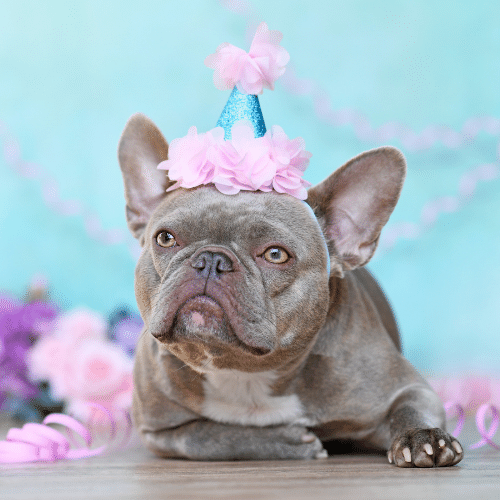
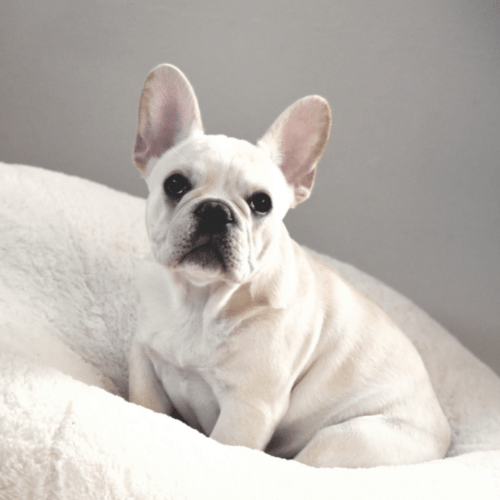
5. Cream
Cream Frenchies have an eggshell-like color. They are sometimes mistaken as white French Bulldogs. However, they are not nearly as lightly colored. They have a tan-tint that sets them apart.
Furthermore, these dogs will also have darker lips and eye rims. They don’t appear as washed-out as white French Bulldogs, who have pink lips and eye rims. If you’re having trouble telling a white Frenchie apart from a cream one, check their lips and eye rims.
This color is one of the few on this list that the AKC accepts. Therefore, it may appear in dog shows occasionally. However, its rarity still means that more common colorations often overtake it.
6. Pure Black
Completely black French Bulldogs are difficult to find. They are black dogs that don’t have the genetics for any marking, making them come out as entirely black. It isn’t easy to find a Frenchie without markings, so most pure black dogs are pretty expensive.
Many “pure black” Frenchies may have small amounts of white markings on their chest. Just because a dog is advertised as entirely black doesn’t mean that they are entirely black. Be sure to ask for pictures of the dog before settling on a puppy.
Many people are very drawn to the utterly black coloration. However, they tend to be rarer, so you may end up paying a bit more for them.
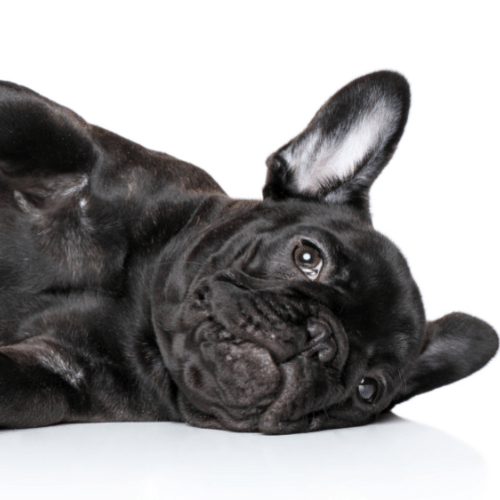
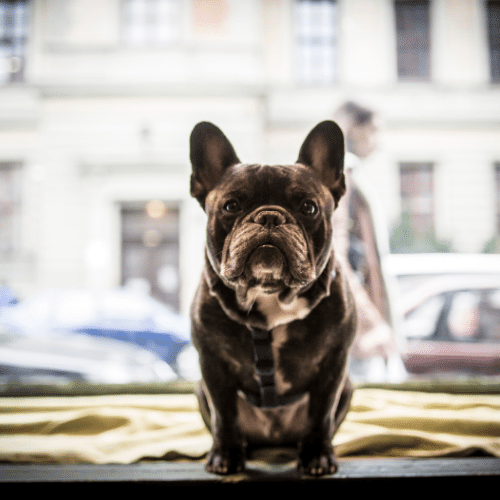
7. Black and Tan
As the name suggests, a black-and-tan French Bulldog is almost all black, except for a few tan markings. These markings are usually on their face, ears, neck, and chest. Some dogs have more tan markings than others. The exact shade also varies quite a bit. Some are lighter and may fall into the fawn category. Most will be a darker brown, however.
Despite not being completely black, these dogs are still more expensive than your average Frenchie. You usually have to find a breeder specializing in black dogs, as they can be difficult to find otherwise. There are no health problems associated with this specific coloration.
8. Black and White
Black-and-white French Bulldogs are primarily black but with a few white markings. This color shouldn’t be confused with the Piebald pattern, which can also occur in French Bulldogs with some regularity. Piebald dogs are almost entirely white with a few different spots of color. The color of the spots doesn’t matter.
However, black and white French Bulldogs will be primarily black. The white markings usually only occur on their neck and chest. Some may have more white markings on their face, belly, and legs.
The extent of the white markings varies widely and can be difficult to determine until the dog gets older. Usually, what the dog looks like as puppies is not a good indication of what they’ll look like as adults – especially when markings are in play.
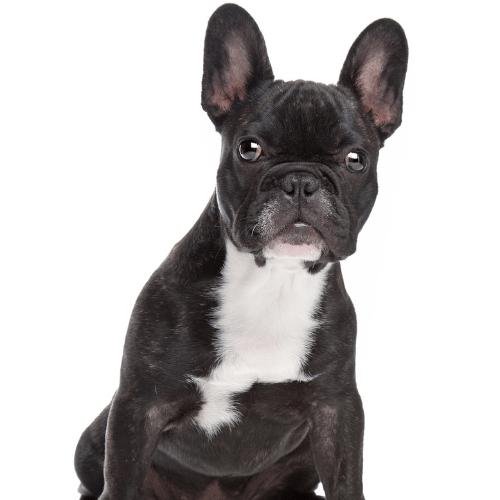
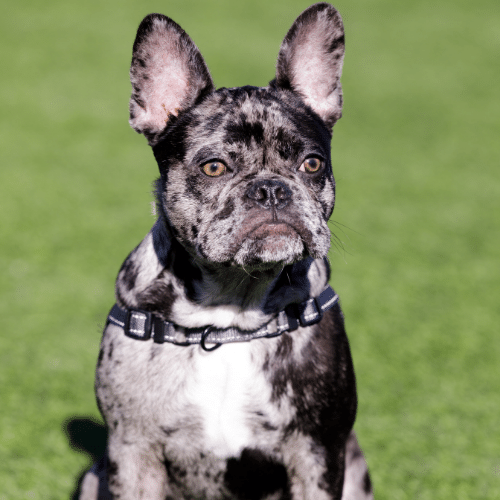
9. Merle
Merle is probably one of the most controversial French Bulldog colors. While Frenchies naturally carry the genetics for the genes we have previously discussed, this is not true for the merle gene. The genetic code for this color had to be introduced to the genetic line somewhere. It is expected that most merle French Bulldogs have Chihuahuas somewhere in their pedigree.
The Merle gene causes mottled patches of color instead of the dog’s usual color. It is a dominant gene, so the dog only needs one to end up as a complete Merle. This gene only affects the coloration on a black-based coat, not a red one. Therefore, you will see some chocolate Frenchies with a “hidden merle.” Often these dogs look entirely normal, except they have very light-colored eyes.
While dogs only need one gene to be considered merle, two merle genes will make them “extra” merle. This double-gene usually won’t affect their actual coloration very much. However, it will make them more prone to health problems.
The main problem with the merle gene is that it has been shown to cause health problems in all the dog breeds that it affects. We may not have exact data on Frenchies, as the merle pattern is infrequent in this breed. However, we know that it negatively affects the Chihuahua, which is likely where the French Bulldog got the merle gene.
These dogs are prone to a variety of eye problems. The merle gene affects how the dog makes pigment, including in their eyes. Therefore, many of these dogs end up with some sort of eye issue, such as microphthalmia, ocular pressure problems, and colobomas, among others.
Hearing problems are common as well. One study found that dogs with single merles have a 2.7% of being deaf in one ear and a 0.9% chance of being deaf in both. On the other hand, double merles had a 10% chance of being deaf in one ear and a 15% chance of being deaf in both.
This study isn’t including slight levels of hearing loss that likely affects many more dogs.
Luckily, many dogs adapt well to being deaf or blind. In many cases, you may not notice that your dog is deaf or blind until months down the road. Most dogs won’t show signs of blindness until they become completely blind and are then placed in a new environment.
10. Blue Fawn
The blue fawn French Bulldog is fawn but with the dilution gene. These dogs don’t look blue at all. However, they do have the gene to make blue puppies, so they are commonly referred to with blue in their name. They often have signs of dilution on their mask, noses, ears, and paw pads.
They also have a slightly different mask color, which is how they are distinguished from regular fawn Frenchies. They also have lighter eye color, as the dilute gene tends to affect their eyes as well.
These dogs vary widely in cost. While they may not look very exotic, they are often sold for more because they can produce blue puppies. However, those sold without breeding rights are often relatively inexpensive. Usually, these dogs cost anywhere from $4,000 to $10,000.
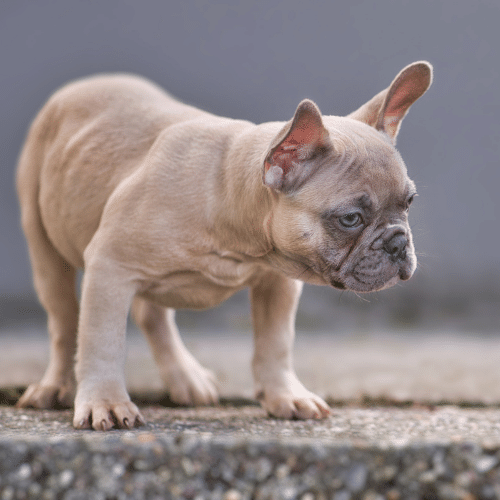
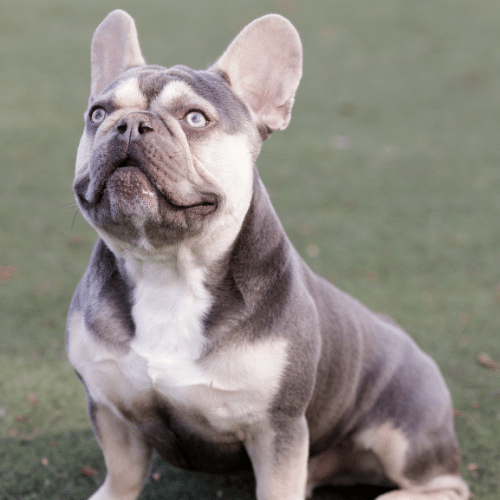
11. Isabella French Bulldog
The Isabella French Bulldog isn’t technically a different color from lilac. Often, they look the same as a lilac. They also have the same genetic code: two copies of the chocolate gene and two copies of the dilution gene.
The only reason this color gets its name is that the chocolate is testable. This means that the breeder genetically tested the dog to ensure that it was carrying the chocolate gene. This is the only way to ensure that the dog is an Isabella Frenchie. You can’t simply look at a dog and say that it looks like an Isabella. It has to be tested.
Because the extra testing goes into proving that these dogs are true lilacs, they often cost more. Usually, these dogs can cost as much as $15,000 to $40,000. They are easily one of the most expensive French Bulldog colorations out there.
Currently, these are the most difficult French Bulldogs to find. You have to go to a breeder specializing in this coloration and then likely sit on a waiting list for a long time. Due to their increasing popularity, there is a chance that they will become less rare in the future. After all, breeding two Isabella French Bulldogs together will give you a litter full of them.
Why doesn’t The AKC accept all Colors?
The only colors currently accepted by the AKC are white, cream, fawn, and variations of these colors. Markings are allowed as well.
One of the main reasons these colors are accepted above others is because they were the most common colors when the breed standard was written. The breed did carry these genetic traits for the most part since they were first bred. However, because many rarer traits are recessive, they didn’t show up with any degree of regularity until breeders began selectively breeding for them.
Many of these colorations have just now come into the forefront. The AKC may accept them in the future, but they are currently not seen as “normal” colors.
What’s the most expensive French Bulldog color?
The most expensive color is the Isabella Frenchie. This color involves the dog inheriting two copies of two rare genes. These genes are rare by themselves. When you try to breed a puppy with both, it often takes a considerable amount of time and effort.
Plus, these dogs have been genetically tested to ensure that they do have the two-color genes they look like they have. Often, dog colors can be a bit confusing. It isn’t uncommon for a dog to appear to have one color but not have it from a genetic standpoint. While this isn’t any problem for pets, it can be a problem for breeders.
Knowing precisely the genetics a dog has is very helpful to breeders, as it helps them breed the specific puppies they want.
Often Isabella dogs are purchased by other breeders to produce more Isabella dogs. That is one reason why they are so expensive; they are priced for breeders who will make money on the dog’s puppies.
In recent years the so-called “Fluffy Frenchies” have become increasingly popular. These dogs easily go for high 4-figures or even 5-figures. If you are looking for a breeding quality Fluffy Frenchie in a rare color, you may pay over $15,000 for a puppy.
What is the best color for a French Bulldog?
There is no “best color” for the French Bulldog. The color only affects aesthetics in most cases, though some do affect health. Which one you choose largely depends on which color you like the best, as well as what you’re willing to pay for it. You may like how lilac dogs look but not be willing to pay thousands of dollars for them.
Some people consider the best colors to be those without any health problems attached. This would make all colors suitable except for those with the dilute gene and the merle gene. Truthfully, this eliminates many rarer colors, as many of them rely on the dilute blue gene.
If you’re looking for cost-effectiveness alone, you’ll likely be better off purchasing a standard coat color. French Bulldogs tend to be expensive anyway. Sometimes, it simply doesn’t make sense to pay extra for rare coat color. A Frenchie is a Frenchie – no matter what they look like.
What is a platinum French Bulldog?
The “platinum” French Bulldog is a cream – just with a fancy name. There is no difference, but some breeders will attempt to sell their dogs for extra because they are “rare” – even though they are not any more exotic than the cream.
These dogs are not particularly rare, though they are rarer than some other colorations. These dogs can easily cost a few thousand dollars extra. But you shouldn’t pay tons of extra money based on their fancier name.
Are Tan French Bulldogs rare?
French Bulldogs with any sort of tan marking tend to be rarer than some other markings and colorations. However, this doesn’t mean that they are entirely unheard of or the rarest dog out there. Often, there are plenty of tan puppies available at any one time, but you may have to pay a bit extra for them.
These markings are not the rarest by any means. However, if they are added to another rare coat, you can expect them to be quite a bit more expensive. A black Frenchie with tan markings is often more expensive than a plain black Frenchie – who are usually expensive anyway.
You often have to find a breeder that mainly produces puppies with tan coloration. Otherwise, these dogs can be hard to find. Breeders often have to have dogs on hand with the tan coloration. Otherwise, they likely won’t be producing any puppies with it.
What color is my Frenchie?
Figuring out the color of your French Bulldog can be challenging. In most cases, you’ll need to ask your breeder. If this isn’t possible, check the dog’s pedigree to understand what genes they might have inherited. Sometimes, this is easy to figure out. Other times, not so much.
If the parents had a recessive coat color, it is often easy to figure out what genes they passed onto the puppies. There simply aren’t any other options but the recessive genes. However, parents with dominant coat colors can be carriers of other genes. This situation makes it extremely difficult to figure out what genes your puppy inherited, as you don’t know the exact genetics of the parent dogs.
The only sure way to know the genetic code of your dog is to get it tested. There is a reason “tested” dogs are more expensive than others. Their coat color has been proven. Someone genetically tested it instead of guessing based on what they looked like.
Conclusion
There are many rare French Bulldog colors out there. Many of these are pretty expensive, as you might expect. More coat colors are being produced all the time, primarily because it pays to produce rare Frenchies.
However, some of these colors are prone to health problems, so be sure to do your research before you buy something simply because it looks nice. The last thing you want to buy is an expensive dog that also has expensive health problems.
In the end, what French Bulldog you want to purchase depends largely on your aesthetic preference. If you want a rarer dog, you should plan on waiting longer and paying more.

Author: Kristin
Kristin was born in Tennessee and currently lives there with her husband and children. She is passionate about educating pet parents and helping them make the best possible decisions for their pets. She currently owns one dog, two cats, a lizard, and a variety of fish.

